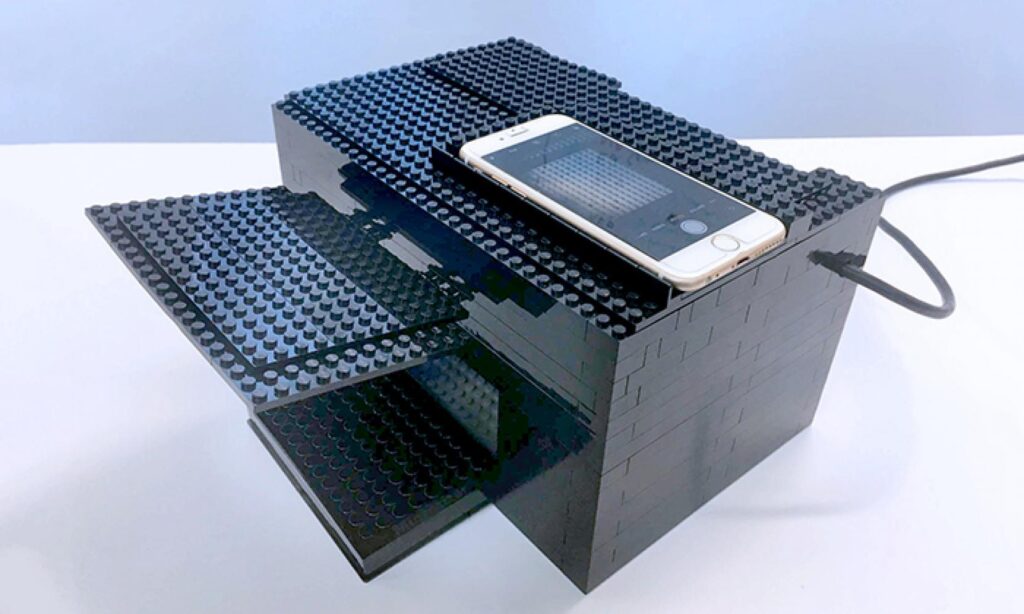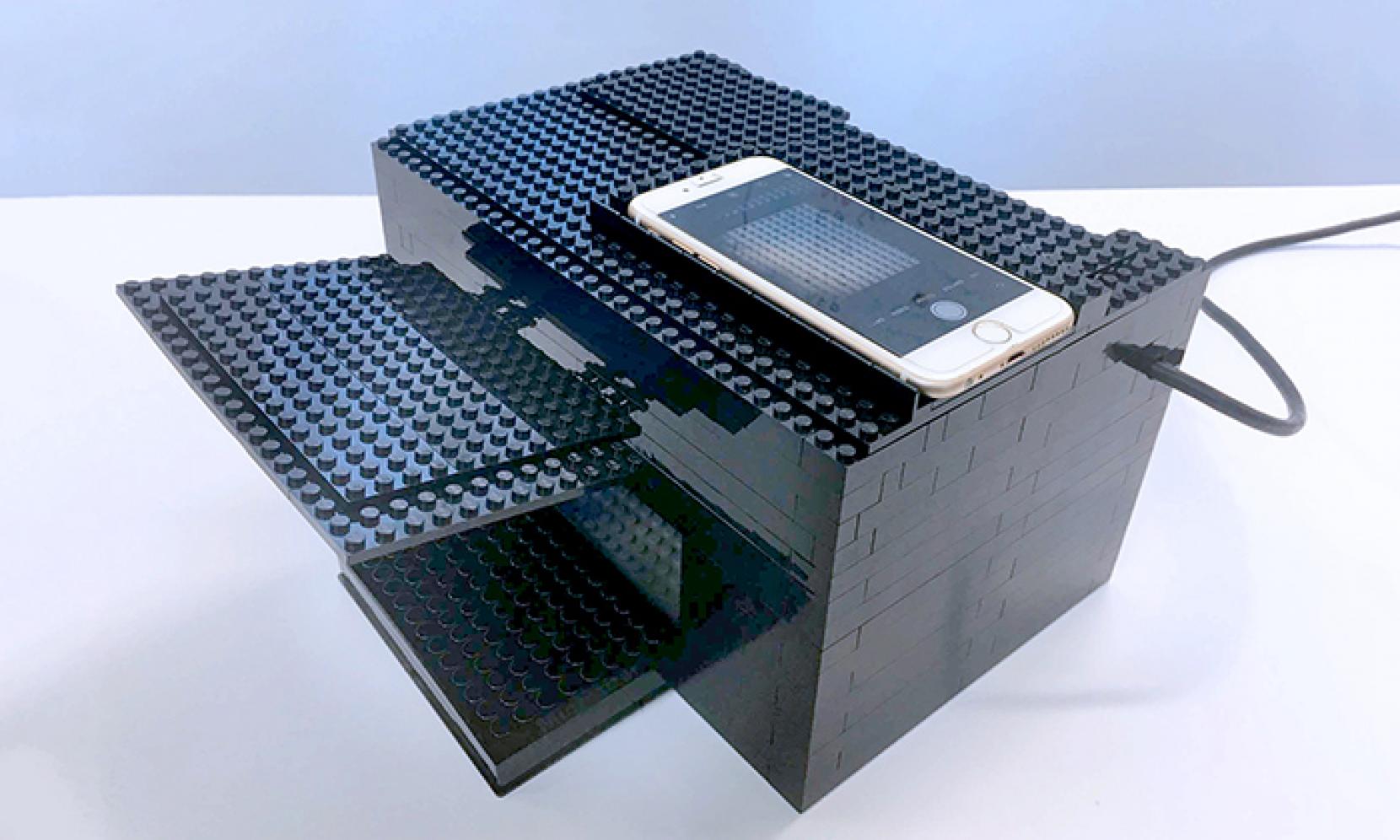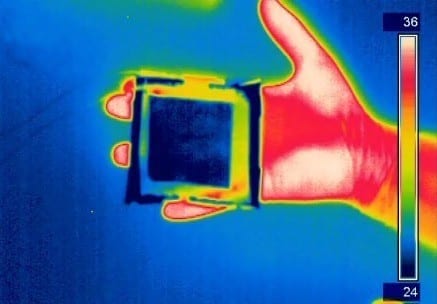
Researchers at The University of Texas at Austin have designed a way to sense dangerous chemicals using, in part, a simple rig consisting of a smartphone and a box made from Lego bricks, which could help first responders and scientists in the field identify deadly and difficult-to-detect nerve agents such as VX and sarin.
The new methodology described in a paper published Wednesday in the open-access journal ACS Central Science combines a chemical sensor with photography to detect and identify different nerve agents — odorless, tasteless chemical weapons that can cause severe illness and death, sometimes within minutes.
Eric Anslyn, a chemistry professor at UT Austin, has been studying nerve agents for nearly 20 years, using safe chemical compounds that behave in the same way as nerve agents and can mimic them in testing. He previously developed chemical compounds that neutralize nerve agents and at the same time create a glow bright enough to be seen with the naked eye.
“Chemical weapons are dangerous threats to humanity,” Anslyn said. “Detection and neutralization are key to saving lives.”
The new device uses affordable, accessible materials to make Anslyn’s earlier compound more useful in real-world scenarios. The chemical sensors, developed by Xiaolong Sun in Anslyn’s lab, generate fluorescence, which is key to the analysis. Different colors and brightness can signal to first responders which of several nerve agents are present and how much. Because different categories of nerve agents require different decontamination procedures and different treatments for victims — and because the weapons act swiftly, making time of the essence — these variations are key.
“Unfortunately, it can be difficult to see differences in the level of florescence with the naked eye in the field. And instruments used in the lab to measure florescence are not portable and cost $30,000,” said Sun. “This device essentially takes photographs of the glowing.”
The camera on a smartphone is sensitive enough to detect the differences in color and brightness in the glowing reaction. The team used an iPhone in the lab. Software, developed by graduate student Alexander Boulgakov and available for free on GitHub, analyzes the color and brightness to identify the type and concentration of the nerve agent. The software can be adapted for multiple smartphone systems.
But researchers also needed a light-tight space to get a good reading on the camera. They considered 3D-printing a box, but realized that 3D printers and the materials used in them can be inaccessible, uneven or cost-prohibitive in some parts of the world. That’s when Pedro Metola, a clinical assistant professor at UT, thought of using Legos.
“Legos are the same everywhere you go,” Metola said.
The only other pieces of equipment needed are an ultraviolet light and standard 96-well test plate. The solution is inexpensive, portable and adjustable on the fly.
Learn more: New Nerve Gas Detector Built with Legos and a Smartphone
The Latest on: Nerve gas detector
[google_news title=”” keyword=”nerve gas detector” num_posts=”10″ blurb_length=”0″ show_thumb=”left”]
via Google News
The Latest on: Nerve gas detector
- Gas Detectors: Key Differences and Uses of Fixed vs. Portable Modelson May 9, 2024 at 1:13 am
Gas detectors prevent invisible hazards. These devices detect numerous gases, from industrial pollutants to carbon monoxide, whether fixed or portable. Understanding how portable gas detectors work, ...
- Best Carbon Monoxide Detector for 2024on May 7, 2024 at 2:51 am
Having a carbon monoxide detector in your home will help protect your household from this potentially deadly gas. The detector can alert you to the presence of dangerous levels of CO and give you ...
- Your Ultimate Carbon Monoxide Detector Guideon April 18, 2024 at 7:24 am
fuel-burning appliances such as gas stoves and running cars in an attached garage. However, most CO poisoning can be avoided by installing carbon monoxide detectors throughout the home.
- Your Ultimate Smoke Detector Guideon April 18, 2024 at 5:29 am
Sadly, half of all house fire-related deaths occur in homes with working smoke detectors. That’s why smoke detector knowledge is so important. This smoke detector guide will help you protect ...
- Three arrested over tube nerve gas ploton April 13, 2024 at 5:00 pm
Seven years ago a nerve-gas attack on the Tokyo subway killed 12 people and injured 5,000 others. The attack by a Japanese religious cult Aum Shinrikyo served as a wake-up call to the world of the ...
- Cold War Documents Show Familiar Worries Over Nuclear Weaponson April 19, 2022 at 10:15 am
Edgar Hoover shows the F.B.I. discussing limiting the size of the diplomatic mail pouch or directing diplomats to enter the country through ports with radiation detectors. The handwritten note is ...
- Nerve Gas Antidoteson January 11, 2019 at 4:17 am
Chemical weapons are a rising global threat. At Mississippi State, our researchers are fighting back, developing antidotes designed to defeat harmful nerve agents and save lives. Audio Transcription: ...
- The Electronics Of Cold War Nightmareson November 26, 2018 at 8:36 pm
[Msylvain59] tears down two examples: a Soviet GSP-11 nerve agent detector and a Polish RS-70 radiation alarm. You can see both videos, below. In all fairness, the GSP-11 is clearly not meant for ...
- Portable Gas Detectoron June 6, 2017 at 8:33 am
Durable, high-performance, 4-gas detector runs for 24 months straight without running out of battery. This compliance-based, low-maintenance, portable gas detector, the Multi Gas Clip Simple ...
via Bing News










